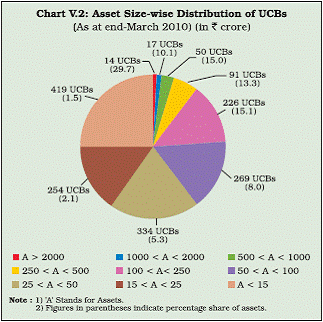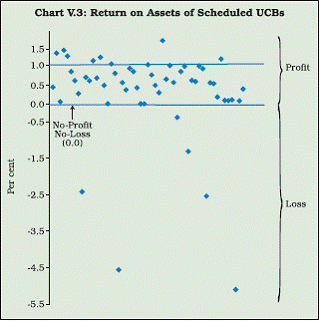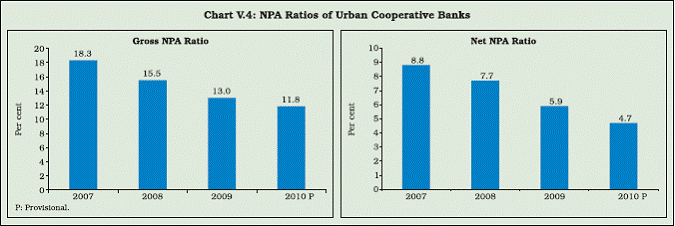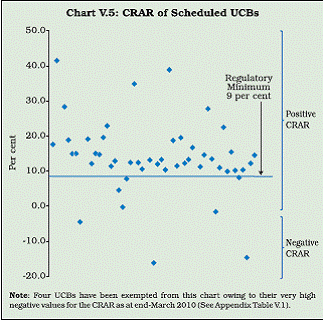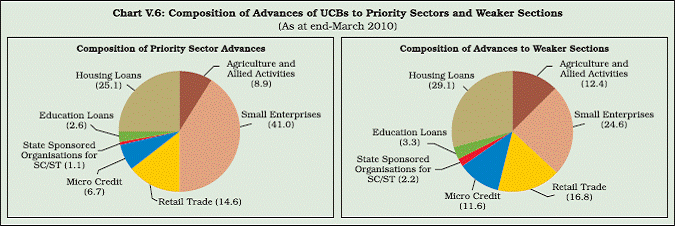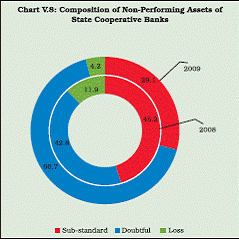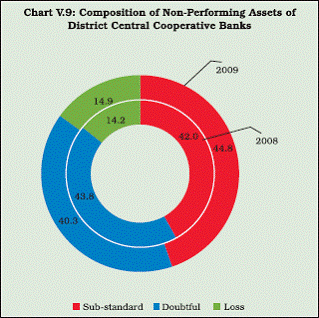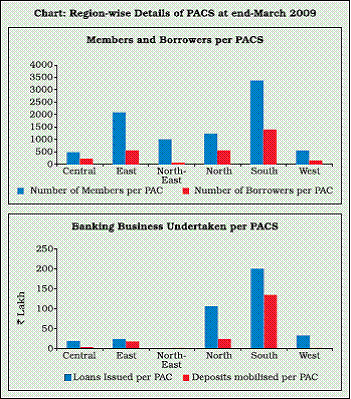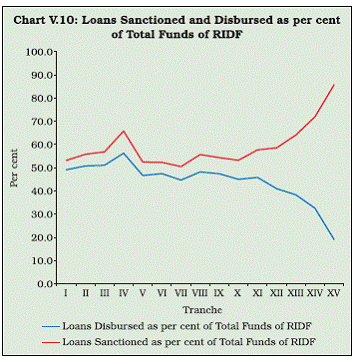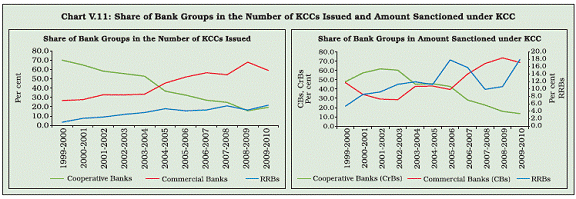Developments in Cooperative Banking - આરબીઆઈ - Reserve Bank of India
Developments in Cooperative Banking
This chapter analyses the financial performance and soundness of the cooperative sector, both urban and rural, in the context of their role in furthering financial inclusion. The urban cooperative sector reported overall net profits as at end-March 2010 with improved asset quality. The overall financial performance of the rural cooperative sector witnessed some improvement at end-March 2009 over the previous year, though the asset quality deteriorated. However, the financial position of ground level institutions in the rural cooperative sector is a cause for concern as they reported losses alongside a high NPA ratio. Further, the role of the cooperative sector in the Kisan Credit Card Scheme, in terms of number of cards issued as well as amount of credit sanctioned, exhibited a declining trend during the recent years. 1. Introduction 5.1 The wide network of cooperatives, both urban and rural, supplements the commercial bank network in its efforts to deepen financial intermediation by bringing large number of small depositors/borrowers under the formal financial network. However, these two sets of banks are not strictly comparable owing to reasons those stem from their origins, objectives and regulatory environment they are subjected to. Origins of the cooperative movement in India can be traced back to the Cooperative Credit Societies Act, 1904. The wide geographical coverage of cooperatives especially in rural areas was primarily established to save small borrowers hailing from rural areas from usurious interest rates charged by money lenders. Since its inception, it has been playing an important role in the socio-economic development of the country by making available institutional credit at affordable cost particularly to the agricultural sector. In the process, the cooperative movement in India has facilitated the process of financial inclusion. Howsoever, the weak financial position of majority of cooperative credit institutions has been a cause for concern. 5.2 The cooperative sector in India is divided into two major segments, viz., the Urban Cooperative Banks (UCBs) and Rural Cooperatives. As names indicate, UCBs concentrate on credit delivery in urban areas, while Rural Cooperatives concentrate on rural areas. The structure of the cooperative banking sector in India is provided in Chart V.1. 5.3 The regulation of banking-related activities of the UCB sector is under the purview of the Reserve Bank, while the incorporation/registration and management-related activities are regulated by the Registrar of Cooperatives Societies or the Central registrar of cooperative societies as the case may be. In order to deal with the issue of dual control in the regulatory framework of the urban cooperative sector, MoUs have been entered into with the Central Government and all 28 States. Task Forces for Cooperative Urban Banks (TAFCUBs) have also been constituted in all these States and a Central TAFCUB has been constituted for the multi-State UCBs. The regulation and supervision of the rural cooperative sector (State Cooperative Banks (StCBs) and District Central Cooperative Banks (DCCBs)) is much more complex with a triangular structure, where the Registrar of cooperatives, the Reserve Bank and the NABARD are entrusted with separate responsibilities. For the rural cooperative sector, MoUs have been entered into by majority of State Governments with the NABARD. 5.4 In this context, this chapter provides an analysis of recent trends in operations and performance of urban and rural cooperative credit institutions in India using the latest available data. The chapter is organised into five sections. Section 2 discusses business operations and performance of UCBs during 2009-10, while Section 3 focuses on performance of rural cooperative credit institutions during 2008-09. Section 4 documents initiatives taken by NABARD followed by concluding observations in Section 5.
2. Urban Cooperative Banks1 Profile of UCBs 5.5 The urban cooperative banking sector comprises a number of institutions which vary in terms of their size, nature of business and geographic spread while concentrating on credit delivery in urban areas. As an outcome of the on-going consolidation of the sector, there was a decline in the number of UCBs at end-March 2010 to 1,674 from 1,721 in the previous year.2 The progress made so far in the consolidation of the UCB sector is provided in Box V.1. Grade-wise Profile of UCBs3 5.6 On account of the consolidation process going on in the UCB sector, percentage of banks in grades III and IV witnessed a declining trend during recent years. Further, the absolute amount of deposits as well as advances with UCBs in grades III and IV also witnessed a decline as at end-March 2010 as compared with the previous year. Accordingly, the percentage of banks in grades I and II as also their share in total deposits and advances of the sector exhibited a rising trend during the recent years. This implies a shift in the concentration of banking business in favour of financially sound UCBs. The value of normalised Herfindahl-Hirschman Index for the UCB sector increased to 0.38 as at end-March 2010 from 0.30 in the previous year, indicating an increase in the concentration of banking business with grade I banks in the sector (Table V.1).4 Box V.1: Consolidation and Strengthening of the UCB Sector Weak financial position of a number of UCBs has been the major cause for concern in the UCB sector for decades. The dual regulatory control over this sector contributed a lot to the weak financial position of this sector. To address this issue, the Reserve Bank in March 2005 prepared a vision document and based on that a Medium-Term Framework (MTF), which envisaged regulatory coordination between the two main regulatory authorities of the urban cooperative banking sector, viz., the Reserve Bank and the respective State Governments (Central Government for multi-State UCBs) through signing of a Memorandum of Understanding (MoU) in each State within the existing legal framework. As on date, MoUs have been entered into with Central Government and all 28 States having presence of UCBs, thus covering the entire UCB sector. Task Force for Cooperative Urban Banks (TAFCUBs) have been constituted in all these States and a Central TAFCUB has also been constituted for the multi-State UCBs. The supervisory actions taken on the basis of recommendations of the TAFCUBs include cancellation of licenses or rejection of license applications of unviable UCBs, supersession of errant Board of Directors, and placing/modification of operational restrictions/directions on the banks. Other important policy measures that were implemented based on a consensus in the TAFCUBs, were Guidelines on ‘Fair Practice Code for Lenders’ and issue of Guidelines on ‘Fit & Proper Criteria’ for appointment of CEOs of UCBs. Further, TAFCUBs identify the potentially viable UCBs and suggest solutions for their revival while formulating non-disruptive exit strategies for non-viable banks. The exit of non-viable banks could be through merger/amalgamation with stronger banks, conversion into societies or liquidation, as the last option. With a view to facilitating consolidation, and nondisruptive and orderly resolution of weak/unviable entities in the UCB sector, the Reserve Bank had framed in February 2005, guidelines for merger/amalgamation of UCBs. In terms of these guidelines, the acquirer bank has to protect deposits of the acquired bank on its own or with upfront financial assistance from the State Government. In order to give a fillip to the process of mergers and consolidation of the sector and to address the legacy cases of UCBs with negative net worth as on March 31, 2007, the Reserve Bank issued in January 2009 additional guidelines for merger/amalgamation of UCBs which provided for DICGC support to the extent and in the manner prescribed under Section 16(2) of the DICGC Act 1961, financial contribution by the acquirer bank and sacrifice of a portion of their deposits by large depositors. Out of a total of 103 NOCs for merger issued by the Reserve Bank, 91 were in respect of weak banks. Of these 91, 71 mergers have so far been notified by the RCS of the respective States (Table). As an additional option for resolution of weak UCBs, where proposals for mergers were not forthcoming from within the UCB sector, guidelines were issued by the Reserve Bank in February 2010 for sanction of a scheme of transfer of assets and liabilities (including branches) of UCBs to commercial banks with DICGC support, in legacy cases of banks with negative net worth. These guidelines provide for 100 per cent protection to all depositors and DICGC support is restricted to the amount provided under Section 16(2) of the DICGC Act, 1961. UCBs which had negative net worth as on March 31, 2007 or earlier and continue to have negative net worth as on the date of transfer would be considered eligible under the scheme. As an incentive, the Reserve Bank would permit the transferee (commercial) bank to take over branches and close down the loss incurring branches of the transferor bank (UCB) with the prior approval of the Reserve Bank. The shifting/relocation of branches of the transferor bank may also be permitted by the Reserve Bank subject to banking facilities being made available to customers through the existing/relocated branches of the transferor/ transferee bank. Size of Assets-wise and Business-wise Profile of UCBs 5.7 To further understand the extent of concentration in the UCB sector, an analysis of asset size-wise as well as size of deposit and advances-wise profile of UCBs is attempted in this section. The analysis shows that there was an increase in the number of banks as also an increase in the share of banking business in the larger asset-size categories as well as in the larger business-size categories of banks. 5.8 The size of asset-wise distribution of UCBs shows that there was a decline in the number of banks in the category ‘asset size below `100 crore’ with a corresponding increase in the ‘above `100 crore’ category as at end-March 2010 as compared with the previous year. The share of the former category in the total assets of the UCB sector also witnessed a decline as compared with the previous year. Consequently, as at end-March 2010 almost three-fourths of UCBs had assets below `100 crore; however, their share in the total assets of the sector was around one sixth of the total assets of the entire sector (Chart V.2).
5.9 The size of banking business-wise classification of UCBs shows that less than one fifth of total UCBs accounted for more than three fourth of deposits as at end-March 2010. Similarly, a little more than one tenth of total UCBs accounted for almost 70 per cent of total advances as at end-March 2010. Further, the share of UCBs with deposits or advances less than `100 crore in the total deposits and advances declined as at end-March 2010 as compared with the previous year (Table V.2). Tier-wise and Scheduled Status-wise Profile of UCBs 5.10 UCBs are also classified into scheduled and non-scheduled as well as into tier I and tier II categories.5 In terms of number of banks, the sector was dominated by non-scheduled tier I banks, however, in terms of size of the banking business the sector was dominated by scheduled tier II banks. The banking business per UCB was the highest in scheduled tier II banks followed by non-scheduled tier II and non-scheduled tier I. Thus, tier II banks, both scheduled and non-scheduled together, accounted for around 80 per cent of the total banking business of the sector as at end-March 2010 (Table V.3). 5.11 There was a decrease in the number of non-scheduled UCBs at end-March 2010 over the previous year, while the number of scheduled UCBs remained unchanged during the same period. However, the number of tier II UCBs in the non-scheduled sector increased as at end-March 2010 over the previous year. Thus, the decline in the total number of UCBs was on account of a decline in the non-scheduled Tier I UCBs in Grades III and IV. Since these banks are classified as financially weak, a reduction in the number of these banks implies, ceteris paribus, an overall improvement in the financial strength of the sector. This may be attributed to the consolidation process initiated by the Reserve Bank as mentioned in Box V.1.
Balance Sheet Operations of UCBs 5.12 Balance sheets of UCBs expanded at a higher rate at end-March 2010 over the previous year, which can be attributed to deposits on the liability side, and investments and disbursement of loans and advances on the asset side. While the growth of capital accelerated at end-March 2010, reserves also grew at a high rate of around 20 per cent, though at a decelerated pace during the same period. Deposits were the major liability of the UCB sector, implying that the sector is heavily dependent on deposits for resources. On the assets side, while loans and advances constituted almost half of total assets, investments grew at the highest rate constituting a little more than one third of the total assets (Table V.4). 5.13 Balance sheets of scheduled UCBs witnessed higher expansion than the balance sheets of non-scheduled UCBs as at end-March 2010 over the previous year. In both the scheduled and non-scheduled segments, expansion in the balance sheets was contributed by deposits on the liability side. On the asset side, while scheduled UCBs used their funds for disbursements of loans and advances as well as for investments, non-scheduled UCBs used their funds primarily for investments. Investments of Urban Cooperative Banks 5.14 The investment profile of UCBs shows that majority of investments of UCBs were in SLR instruments, constituting more than 80 per cent of the total investments of UCBs as at end- March 2010. Investments in Central Government securities constituted around half of the total SLR investments as at end-March 2010. Notably, the second major investment of UCBs was term deposits with DCCBs. UCBs were also having considerable amount of term deposits with StCBs. This highlights the interconnectedness of the urban and rural cooperative sectors (Table V.5). 5.15 The non-SLR investments of scheduled UCBs grew at a higher rate than that of nonscheduled UCBs at end-March 2010 over the previous year. On the contrary, SLR investments grew at a higher rate for non-scheduled UCBs as compared to scheduled UCBs (Table V.6). Financial Performance of UCBs 5.16 In response to measures undertaken in the sector, the financial performance of UCBs witnessed considerable improvement over the last one decade. The scheduled UCB sector started reporting overall net profits since 2003-04 as compared with net losses prior to it. Accordingly, the return on assets (RoA) of the scheduled UCB sector witnessed a rising trend during the last one decade. However, owing to the spillover effects of the global financial turmoil, net profits declined during 2008-09 and 2009-10. Consequently, the sector reported lower RoA during the last two years as compared with 2007-08. The decline in RoA was mainly due to a decline in net interest margin (NIM) and non interest margin (Non-IM) during the last two years. An analysis of return on assets (RoA) of the scheduled UCB sector for the last one decade is provided in Box V.2.6
5.17 All major items of the profit and loss account of the UCB sector witnessed deceleration as at end-March 2010 over the previous year. However, the deceleration was more on the income side than on the expenditure side leading to lower overall operating profits as compared with the previous year. Though there was a decline in provisions and contingencies, it could not compensate for the decline in operating profits. Net profits, therefore, witnessed a decline at end-March 2010 as compared with the previous year. Accordingly, there was a decline in the return on assets (RoA) as well as net interest margin (NIM) of the sector as at end-March 2010 over end-March 2009. The non-interest margin continued to be negative at end-March 2010 as in the previous year. The non-interest income registered an absolute decline at end-March 2010 over the previous year. 5.18 The interest income of scheduled UCBs grew at a higher rate than that of non-scheduled UCBs at end-March 2010 over the previous year. Despite this, the non-scheduled UCBs were able to post higher net profits because of the deceleration in operating expenses, especially the staff expenses during the same period. The noninterest income of both the scheduled and nonscheduled sectors posted a decline as at end- March 2010 over the previous year (Table V.7). 5.19 Accordingly, while the RoA of scheduled UCB sector witnessed a decline, the RoA of the non-scheduled sector increased. Bank-wise RoAs of the scheduled UCB sector revealed that a few banks are incurring heavy losses, while some others are at the margin, i.e., almost no profit no loss position, and majority of banks are placed within the band 0 to 1 per cent. The presence of loss making banks, especially in the scheduled UCB sector is a cause for concern as banks in the scheduled UCB sector are large sized banks handling considerable banking business (Chart V.3, and Appendix Tables V.1 and V.2). Box V.2: Actual RoA vis-à-vis Potential RoA – An Analysis of Scheduled Urban Cooperative Banks The return on assets of scheduled UCBs witnessed a rising trend over the last one decade. The ROA which was negative up to the year 2002-03, turned out to be positive in the year 2003-04 and remained positive thereafter. However, during the last two years, RoA exhibited a declining trend. An attempt has been made to understand the deviation of actual RoA from its potential during the last one decade. The potential RoA is arrived at by taking the highest net interest margin (NIM) and non-interest margin (Non-IM), and the lowest provisioning requirements achieved during the last one decade (Table). It is visible from the chart that actual RoA deviated from its potential throughout the decade. The analysis shows that the deviation of actual RoA from its potential was mainly due to higher provisioning requirements during the first half of the decade. However, during the later years there was an improvement in the asset quality of the sector and as such the provisioning requirements declined. Thus, in the latter half of the decade, the RoA did not reach its potential level mainly because of a lower NIM and Non-IM. However, the unrealised portion of RoA due to lower Non-IM was higher than that due to lower NIM during the second half of the decade. Thus, it is clear that the negative and declining Non-IM is the major factor which is putting a downward pressure on the actual RoA of the scheduled UCB sector followed by NIM. During the last two years NIM as well as non-IM of UCBs witnessed a declining trend.
Financial Soundness of UCBs Asset Quality 5.20 There was an improvement in the asset quality of the entire UCB sector both in absolute and percentage terms as at end-March 2010 over the previous year. However, both gross as well as net non-performing loans of the UCB sector continued to be on the higher side (Chart V.4). 5.21 Along with a decline in the nonperforming loans, there was also an increase in the coverage ratio of UCBs at end-March 2010 over the previous year, indicating improvement in the financial soundness of the sector (Table V.8).
Capital Adequacy 5.22 As at end-March 2010, dominant portion of UCBs were complying with the minimum CRAR norm of 9 per cent. Nonetheless, about 13.7 per cent of total UCBs fell short of meeting the regulatory norm with regard to capital adequacy. Leverage was higher in the case of scheduled UCBs as compared with the nonscheduled category (Table V.9). 5.23 Bank-wise data on CRAR of scheduled UCBs indicated that though majority of them were maintaining CRAR above the regulatory minimum of 9 per cent, some of the scheduled UCBs fell short of minimum level, and more alarmingly, nine UCBs within them reported negative CRAR as at end-March 2010 (Chart V.5 and Appendix Table V.1).
Liquidity 5.24 A rough analysis based on balance sheets of UCBs revealed that even if UCBs keep 100 per cent of their investments in liquid assets, i.e., saleable within one to five days, these banks would be able to manage only a deposit run of 50.9 per cent without any external help. The detailed methodology and assumptions made for this analysis is provided in Box V.3. Financial Inclusion and UCBs 5.25 Along with commercial banks, UCBs are also taking efforts to bring in more depositors and borrowers to the formal network of banking. Box V.3: Liquidity Analysis of Urban Cooperative Banks UCBs are heavily dependent on deposits for resources. In this context, it is important to undertake liquidity stress tests to understand the strength of the sector in the event of a deposit run caused by external factors such as loss of confidence in these banks. However, conducting a stress test, i.e., analysing the liquidity position of UCBs after giving a shock of certain percentage of deposit run, was not possible owing to the unavailability of detailed maturity profile of investments of UCBs. A bank-wise analysis was also not possible due to unavailability of data. Thus, a rough analysis based on the consolidated balance sheets of the UCB sector has been conducted by making certain assumptions about the asset profile of UCBs. Assumptions made are broadly based on those made by the Financial Stability Report for the liquidity stress test of scheduled commercial banks (SCBs). Assumptions 1. A stressed withdrawal of deposits is assumed to take place within a span of five days. 2. UCBs are assumed to meet the deposit run primarily by using liquid resources available with them before resorting to any external help. 3. Among assets of UCBs, loans and advances, and other assets which, inter alia, includes overdue interest receivable, premises, furniture, fixtures, bills and purchased and discounted, are treated as illiquid assets. 4. Further, cash, balances with banks, and money at call and short notice are treated as liquid assets. 5. Apart from these liquid assets, liquid investments, i.e., investments saleable within one to five days, would also be available for meeting the deposit run. 6. Sale of liquid investments is assumed to take place at a haircut of 10 per cent. 7. Seven scenarios have been created by assuming different percentages of total investments to be liquid.
Scenarios developed are based on very stringent assumptions, which are extreme.The detailed calculation of manageable level of deposit run at different percentages of liquid investments for the year 2009-10 is presented in the Table. Data used for the analysis are provisional. The manageable level of deposit run calculated as total liquid funds to total deposits for different levels of liquid investments is depicted in the Chart. It clearly shows that even if UCBs maintain 100 per cent of their investment in liquid assets, they will be able to manage only a deposit run of 50.9 per cent without any external help. It may be noted that 80 per cent of total investments of UCBs are SLR investments. If we assume that all SLR investments are saleable within 5 days, UCBs would be able to manage a deposit run of 42.5 per cent.
No-frills Accounts 5.26 Among initiatives taken so far, introduction of ‘no-frills accounts’ was one of the most important steps to expand the banking network. Notably, UCBs also opened a considerable number of ‘no-frills accounts’ so far. As the non-scheduled UCB sector handles more banking business than the scheduled UCB sector, the number of deposits accounts, ‘nofrills’ accounts as also loan accounts were higher in the non-scheduled sector as compared with the scheduled sector. However, the share of loan accounts of the non-scheduled sector vis-à-vis scheduled sector was particularly striking as the scheduled sector was having only eight per cent of the total loan accounts of the entire UCB sector (Table V.10).
Priority Sector Advances 5.27 Priority sector lending targets introduced in 1983 were mainly aimed at directing a portion of total credit to some specific sectors of the economy which, inter alia, includes weaker sections, small enterprises, and housing.7 As at end-March 2010, about 65 per cent of total advances of UCBs went to priority sectors of which more than 16 per cent of the total advances went to weaker sections (Table V.11). 5.28 The composition of the priority sector lending of UCBs as at end-March 2010 showed that maximum loans under priority sectors went to small enterprises sector followed by housing and retail trade. Further, the composition of lending to weaker sections showed that almost one third of it went to the housing sector and another one fourth went to small enterprises (Chart V.6). Outreach of UCBs across States in India 5.29 The distribution of UCBs across States showed that as at end-March 2010 one third of all UCBs, almost half of all branches of UCBs, around 60 per cent of total extension counters of UCBs and more than 85 per cent of ATMs of UCBs were located in Maharashtra. Accordingly, more than 60 per cent of the total banking business of the UCB sector was concentrated in Maharashtra leaving very low volume of operations in rest of the States (Chart V.7).
5.30 The normalised Herfindahl-Hirschman Index showed that the State-wise concentration of UCBs went up as at end-March 2010 over the previous year. Further, it also showed that State-wise concentration was more in the case of ATMs followed by extension counters, branches and number of UCBs. Similarly, the normalised Herfindahl-Hirschman Index for the grade-wise distribution of UCBs across banking centres showed that concentration was more in grades III and IV UCBs across banking centres as compared with UCBs in grades I and II (Table V.12).
3. Rural Cooperatives 5.31 This section presents an analysis of the financial performance, soundness and balance sheet indicators of rural cooperatives, both short-term and long-term, using the latest available data.8 Financial Position of Rural Cooperatives 5.32 The overall financial position of rural cooperative credit institutions improved as at end-March 2009 over the previous year. As at end-March 2009, half of the total rural cooperative credit institutions reported profits. Profits reported by the sector mainly emanated from DCCBs. While StCBs, DCCBs and State Cooperative Agriculture and Rural Development Banks (SCARDBs) reported overall net profits at end-March 2009, ground level institutions, viz., Primary Agricultural Credit Societies (PACS), and Primary Cooperative Agriculture and Rural Development Banks (PCARDBs) reported overall net losses. Despite the improved financial performance, the asset quality of the sector witnessed deterioration during the same period. The short-term rural cooperative credit institutions had the major share of nonperforming loans of the entire rural cooperative credit institutions as at end-March 2009. Notably, ground level institutions, viz., PACS and PCARDBs reported higher NPA ratios as compared with institutions in upper tiers. Another notable trend in the rural cooperative sector is that while the dependence of shortterm cooperative credit institutions on borrowings continued to be low (except PACS), that of long-term cooperative credit institutions were quite high (Table V.13).
Management of Cooperatives 5.33 As at end-March 2009, boards of around one third of rural cooperative credit institutions (excluding PACS) were under supersession. However, the number of institutions with supersession of boards declined at end-March 2009 over the previous year. Supersession of boards was the highest among SCARDBs at end- March 2009 (Table V.14). Short-term Structure of Rural Cooperatives 5.34 The short-term rural cooperative credit institutions reported overall profits as at end- March 2009 as against overall losses in the previous year. The turnaround in the overall financial position of these institutions was mainly due to profits reported by DCCBs and lower losses reported by PACS as compared with the previous year. Apart from improving the financial position, the balance sheet of these institutions also witnessed an expansion at end- March 2009 over the previous year. StCBs registered the highest expansion of balance sheets followed by DCCBs and PACS. While the asset quality of StCBs and DCCBs improved at end-March 2009 over the previous year that of PACS deteriorated during the same period. Notably, PACS reported the highest nonperforming loans to outstanding loans ratio among rural cooperative credit institutions.
State Cooperative Banks Balance Sheet Operations of State Cooperative Banks 5.35 During 2008-09, balance sheets of StCBs witnessed a higher growth as compared with the previous year, which can be attributed to deposits on the liabilities side and investments on the assets side. However, loans and advances declined at end-March 2009 over the previous year. While the share of deposits in liabilities moved up at end-March 2009 compared to the previous year, the share of borrowings declined. However, the increase in deposits was used for building up investments rather than providing loans, may be because of the increased risk averseness of these banks in wake of the general economic meltdown during the year on the one hand and for reaping treasury gains on the other (Table V.15). 5.36 Updated information on major balance sheet indicators of 16 scheduled StCBs available from Section 42(2) returns shows further improvement in major indicators as at last reporting Friday of 2009-10 over the previous year. The growth in SLR investments witnessed acceleration during 2009-10 over 2008-09. Notably, there was also a revival in bank credit disbursed by scheduled StCBs, which reported a positive growth during 2009-10 as against a contraction during the previous year (Table V.16). Financial Performance of StCBs 5.37 The financial performance of StCBs improved as at end-March 2009 over the previous year in terms of higher net profits, higher ROA, and higher ROE. Not only profitability indicators improved for StCBs, but the number of institutions in profit also increased as compared with the previous year. However, operating profits of StCBs declined as at end-March 2009 over the previous year mainly on account of higher growth in interest expenses and operating expenses as compared with growth in income. StCBs, however, reported higher net profits owing to a decline in provisions and contingencies (Table V.17). Financial Soundness of StCBs Asset Quality 5.38 The asset quality of StCBs improved as at end-March 2009 over the previous year both in absolute and percentage terms. Category-wise details of non-performing loans showed that highest decline was in the loss category. Thus, the share of loss assets in the total nonperforming loans declined in 2008-09 over 2007-08. Similarly, sub-standard assets also witnessed a decline during 2008-09 over the previous year bringing down its share in total non-performing loans in 2008-09 as compared with the previous year. The decline in substandard assets indicates that fresh additions to non-performing loans were comparatively less in 2008-09 as compared with the previous year (Chart 8 and Table V.18). Capital Adequacy 5.39 The capital adequacy of StCBs declined as at end-March 2009 over the previous year. As data on risk weighted assets were not available for StCBs, the ratio of ‘capital and reserves’ to ‘investments and advances’ was taken as a rough indicator of capital adequacy. This ratio declined at end-March 2009 as compared with the previous year. The decline in capital adequacy was mainly on account of a higher increase in investments as compared with marginal increase in capital and reserves (Table V.18).
District Central Cooperative Banks Balance Sheet Operations of District Central Cooperative Banks 5.40 DCCBs form the second tier of the rural short-term cooperative credit structure.9 During 2008-09, balance sheets of DCCBs witnessed a lower growth as compared with the previous year. The growth in balance sheets of DCCBs can be attributed to deposits on the liabilities side and investments on the assets side. On the liabilities side, borrowings of DCCBs witnessed a decline as at end-March 2009 over the previous year indicating a lower dependence on borrowings for resources by DCCBs. In contrast, deposit mobilisation picked up during the year increasing its share in total liabilities of DCCBs. However, as in the case of StCBs, the increased deposit mobilisation was reflected in increased investments rather than an increase in loans and advances. This may either be due to the risk averseness of these banks or may be intended to reap treasury gains (Table V.19). Financial Performance of DCCBs 5.41 There was an overall improvement in the financial performance of DCCBs as at end- March 2009 over the previous year. Importantly, DCCBs reported overall net profits as at end- March 2009 as compared with the reported net losses during the previous year, thus, witnessing a turnaround in their financial position. The number of profit making DCCBs also increased during the same period. Accordingly, profitability indicators such as ROA and ROE also witnessed improvement during the year as compared with the previous year. In contrast with the trend observed in case of StCBs, DCCBs reported higher operating profits as at end-March 2009 mainly on account of higher net interest income. However, the increase in net profits was more than that in operating profits owing to a decline in provisions and contingencies (Table V.20). Financial Soundness of DCCBs Asset Quality 5.42 The asset quality of DCCBs improved as at end-March 2009 over the previous year both in absolute and percentage terms. The absolute decline in total non-performing loans was due to an absolute decline in doubtful loans during 2008-09 over the previous year. However, substandard loans and loss loans increased during 2008-09 over the previous year. During 2008-09, sub-standard loans were the major category in the total non-performing loans followed by doubtful loans and loss loans (Chart 9 and Table V.21). Capital Adequacy 5.43 The capital adequacy of DCCBs witnessed a decline as at end-March 2009 over the previous year. As data on risk weighted assets were not available for DCCBs, the ratio of capital and reserves to investments and advances was taken as the rough indicator of capital adequacy. This ratio declined at end- March 2009 as compared with the previous year. The decline in capital adequacy was mainly on account of a higher increase in investments of DCCBs as against a marginal increase in capital and reserves. As alluded to earlier, loans and advances of DCCBs declined over the same period (Table V.21).
Primary Agricultural Credit Societies 5.44 The PACS function as grass root level short-term rural credit segment of the cooperative sector. Select Balance Sheet Indicators of PACS 5.45 The balance sheet operations of PACS expanded as at end-March 2009 over the previous year. Total resources of PACS increased as at end-March 2009 mainly on account of increase in borrowings followed by increase in owned funds. Needless to mention, PACS were heavily dependent on borrowings for resources. Total loans issued by PACS also increased during the year 2008-09. Medium term loans witnessed a higher growth than short-term loans during the same year. However, out of total loans issued, short-term loans constituted a major portion as at end-March 2009 (Table V.22). Profitability 5.46 The analysis of financial performance of PACS showed that majority of PACS were loss making institutions. As at end-March 2009, a little less than half of total PACS functioning in the country reported losses. However, it may be mentioned that around two third of total PACS were classified as viable and another one fourth were classified as potentially viable as at end- March 2009. Capital Adequacy 5.47 Capital adequacy of PACS witnessed an improvement as at end-March 2009 as compared with the previous year. As data on risk weighted assets for PACS were not available, the ratio of total capital and reserves to total loans outstanding was taken as a rough indicator of capital adequacy. This ratio improved at end-March 2009 as compared with the previous year mainly on account of a decline in the total loans outstanding (Table V.22). Asset Quality 5.48 Asset quality of PACS deteriorated as at end-March 2009 over the previous year. As in the case of capital adequacy, data on non-performing loans were also not available for PACS. Hence, the ratio of total over dues to total loans outstanding was taken as the rough indicator of asset quality. This ratio increased at end-March 2009 as compared with the previous year (Table V.22). Long-Term Structure of Rural Cooperatives 5.49 As in the case of short term rural cooperative credit institutions, the balance sheet of the long-term rural cooperative credit institutions also expanded at end-March 2009 as compared with the previous year. Further, there was an overall improvement in the financial performance of long-term rural cooperative credit institutions as at end-March 2009 as compared with the previous year. While the SCARDBs reported overall net profits as at end-March 2009, PCARDBs reported lower overall net losses at end-March 2009 as compared with the previous year. State Cooperative Agriculture and Rural Development Banks Balance Sheet Operations of SCARDBs 5.50 Balance sheets of SCARDBs witnessed a higher expansion during 2008-09 as compared with the previous year. The expansion in the balance sheets can be attributed to ‘other’ liabilities on the liability side and ‘other’ assets on the asset side.10 Deposits constituted only a small per cent of total liabilities of SCARDBs at end-March 2009. Another striking development in balance sheets of SCARDBs is the decline in capital in 2008-09. However, reserves witnessed a growth over the previous year. Loans and advances declined while investments witnessed a growth as at end-March 2009 over the previous year. This may be due to the increased risk averseness of these banks caused by the general economic meltdown (Table V.23). Financial Performance of SCARDBs 5.51 The financial performance of SCARDBs witnessed improvement as at end-March 2009 over the previous year. SCARDBs reported overall net profits as at end-March 2009 as compared with overall net losses in the previous year. The number of profit making SCARDBs also increased at end-March 2009 over the previous year. Accordingly, they reported higher ROA and ROE during the same period. The interest income of SCARDBs grew at a higher rate during 2008-09, resulting in an increase in the net interest margin. Owing to the higher net interest margin, SCARDBs reported high operating profits as at end-March 2009 as compared with the previous year. However, the increase in net profits was less as compared with the increase in operating profits owing to an increase in provisions and contingencies (Table V.24). Financial Soundness of SCARDBs Asset Quality 5.52 The asset quality of SCARDBs improved at end-March 2009 over the previous year. They reported smaller amount of non-performing loans as at end-March 2009 as compared with the previous year. Non-performing loans to total loans ratio of SCARDBs also declined over the same period. The declining trend in the total non-performing loans was observed across all categories of non-performing loans, viz., substandard assets, doubtful assets and loss assets. Among non-performing loans, loss assets recorded the highest decline followed by doubtful assets and sub-standard assets during 2008-09 over the previous year (Table V.25). Capital Adequacy 5.53 There was an improvement in the capital adequacy of SCARDBs at end-March 2009 over the previous year. The ratio of capital and reserves to investments and advances was taken as the rough indicator of capital adequacy owing to the unavailability of data on risk weighted assets. This ratio increased at end-March 2009 as compared with the previous year. The improvement was mainly because of a decline in the loans and advances (Table V.25). Primary Cooperative Agriculture and Rural Development Banks Balance Sheet Operations of PCARDBs 5.54 Balance sheets of PCARDBs expanded during 2008-09 as compared with a contraction during 2007-08. On the liabilities side, the growth in balance sheets was mainly due to increase in borrowings and ‘other’ liabilities, while on the assets side it was due to increase in ‘other’ assets, and loans and advances.11 Like SCARDBs, PCARDBs depend heavily on borrowings for their resources as deposit mobilisation by these banks are quite low. Accordingly, deposits constituted only a small percentage of total liabilities of PCARDBs, while borrowings constituted almost half of the total liabilities at end-March 2009 (Table V.26). Financial Performance of PCARDBs 5.55 As in the previous year, during 2008-09 PCARDBs reported overall net losses. However, net losses came down at end-March 2009 as compared with the previous year. It is interesting to note that PCARDBs reported overall operating profits at end-March 2009, however, due to the provisioning requirement, they reported overall net losses (Table V.27). Financial Soundness of PCARDBs Asset Quality 5.56 There was improvement in the asset quality of PCARDBs as at end-March 2009 over the previous year, both in absolute and percentage terms. Declining trend was observed across all categories of non-performing loans. Notably, in absolute terms, the highest decline was observed in the case of sub-standard loans (Table V.28). Capital Adequacy 5.57 There was an improvement in the capital adequacy of PCARDBs at end-March 2009 over the previous year. The rough indicator of capital adequacy, viz., ratio of capital and reserves to investments and advances increased at end- March 2009 over end-March 2008 (Table V.28). Financial Inclusion by Rural Cooperatives 5.58 The most justifiable reason to speed up the ongoing revival plan of the rural cooperative sector emanates from the potential of this sector in enlarging the formal financial network especially in rural areas with the existing infrastructure, especially with the wide geographical outreach of PACS. As at end-March 2009, PACS functioning in the country covered around six lakhs villages with a total membership of around 13.2 million. This wide penetration of PACS across villages as well as across small depositors/borrowers would act like a catalyst while pursuing the objective of 100 per cent financial inclusion. Credit- Deposit Ratio of Rural Cooperatives 5.59 The credit-deposit ratio of StCBs and DCCBs was very high as compared with UCBs and SCBs though it came down in 2009 as compared with the previous year. The higher credit-deposit ratio of these upper tier institutions implies a larger availability of funds for PACS (Table V.29).12 5.60 Deposits of long-term cooperative credit institutions such as SCARDBs and PCARDBs were very low as compared with their borrowings. This indicates that long-term cooperative credit institutions need to improve their deposit mobilisation efforts. This would on the one hand help these institutions to diversify their resource base and on the other would bring more depositors under the formal financial network. Outreach of Rural Cooperatives 5.61 In the short-term structure of rural cooperatives, the apex organisation, viz., StCBs play a crucial role in financial inclusion by providing funds to lower tiers of the rural cooperative sector. Every State has one StCB in place to provide funds to the lower tiers of the rural cooperative sector. Though StCBs reported overall profits in majority of States, the poor asset quality of StCBs in the north eastern region is a cause for concern which can impact on the entire rural cooperative sector’s effort to further financial inclusion (Appendix Table V.3).
5.62 The second tier of the rural cooperative sector, namely, DCCBs is present in all regions of the country, except the north eastern region. These banks are concentrated in the central region of the country as at end-March 2009. Notably, majority of them reported overall profits as at end-March 2009. In contrast, ground level institutions, viz., PACS were concentrated in the western region. As at end- March 2009, the average number of villages per PACS was 6 at the all-India level. However, this was very high in some of the regions, viz., central, eastern, north-eastern and northern. In the central region the average number of villages per PACS was 12, which is double of the national average (Appendix Tables V.4 and V.5). 5.63 Branches of SCARDBs were also concentrated in the central region. Though at the All-India level they reported overall net profits, in many States these banks were incurring losses. In contrast, the lower tier of the long-term structure, viz., PCARDBs were concentrated in the southern region followed by the northern region (Appendix Table V.6 and V.7). Business per Branch of Rural Cooperative Credit Institutions 5.64 Among the rural cooperative credit institutions (except PACS), DCCBs were having the maximum number of branches across the country. However, the business per branch was the highest in StCBs. The business undertaken by PCARDBs per branch was very low as compared with other rural cooperative credit institutions. Thus, in terms of number of branches as well as amount of banking business per branch, the short term cooperative credit institutions were far ahead of their long-term counterparts indicating the higher role played by short term rural cooperative credit institutions in financial inclusion (Table V.30).
Role of PACS in Financial Inclusion – Some Emerging Issues 5.65 Over the years, though the network of PACS widened throughout the geographical space of the country, some persisting weaknesses have been making the sector less effective in financial intermediation in rural areas (Box V.4). 4. Role of NABARD in Rural Credit 5.66 In the area of rural credit, NABARD is the apex organisation and as such it has been playing a very important role in enhancing the credit flow to the rural economy since its inception in 1982. It is actively involved in refinancing of rural lending institutions such as RRBs and cooperative credit institutions as also in the recapitalisation of these institutions. Further, NABARD is also entrusted with the responsibility of supervision of rural cooperative credit institutions. Special schemes to improve credit flow to the rural economy, viz., Rural Infrastructure Development Fund (RIDF) and Kisan Credit Card (KCC), are also entrusted with NABARD. Short-term Credit Extended by NABARD 5.67 NABARD provides short, medium and long-term credit facilities to different organisations, viz., StCBs, RRBs and State Governments.13 As at end-March 2010, the total credit extended by NABARD to various organisations witnessed considerable increase over end-March 2009. While, there was an absolute increase in the credit extended by NABARD to StCBs and RRBs in 2009-10 over the previous year, credit extended to State Governments witnessed an absolute decline over the same period. Out of the total outstanding credit from NABARD as at end- March 2010, StCBs accounted for the maximum share followed by RRBs and State Governments (Table V.31). Role of NABARD in Reviving Rural Cooperative Credit Institutions Revival of Short-term Structure - Status 5.68 The approved revival package for rural cooperative credit institutions prepared based on the Vaidyanathan Committee (Task Force on Revival of Rural Cooperative Credit Institutions) Report is under implementation. Government of India has entered into agreements with multilateral agencies such as World Bank, Asian Development Bank and KfW (Kreditanstalt für Wiederaufbau) for financial assistance to implement the revival package at the State level. The National Implementation and Monitoring Committee (NIMC) has been constituted for guiding and monitoring the implementation of the package at national level. At State level, the progress is being monitored by State Level Implementing and Monitoring Committee and at district level by DCCB Level Implementing and Monitoring Committees. At NABARD level, review meetings of Regional Offices of Implementing States are held periodically for the same. Box V. 4 Operations of PACS in India – Some Weak Spots Though PACS have a wide network in the country, there are some inherent weaknesses in the sector which is making this sector less effective in becoming formal financial channels in rural areas. Prima facie, there is a need to increase the number of members in PACS as only members can borrow from PACS. As at end-March 2009, the number of members per PACS at the national level was 1,384. Further, number of members was low in the northern, western, eastern, north-eastern and central regions as compared with that in the southern region. Similarly, only 34.9 per cent of members were borrowers from PACS. As compared with the southern region, the number of borrowers was also comparatively less in other regions of the country. Furthermore, only 19.1 per cent of borrowers of PACS were belonging to SC, ST, small farmers and rural artisans. The banking business undertaken by PACS was concentrated in the southern region. PACS in the southern region mobilised the highest share of total deposits at all-India level. Similarly, PACS in the southern region also had the highest share of loans and advances issued as at end-March 2009. Thus, it is clear that though the western region had the maximum number of PACS as well as lowest number of villages per PACS, PACS in the southern region were engaged in largest amount of banking business. In contrast, at end-March 2009, the banking business undertaken by each PACS was dismally low in the north-eastern region. In this region, the average deposits mobilised by one PACS were `2 lakhs and average loans issued by one PACS were ` one lakh (chart).
Further, it is observed that, out of the loss making PACS, 37.4 per cent belonged to the western region followed by the eastern region (23.4 per cent). On the other hand, profit making PACS were distributed across regions, i.e., 29.8 per cent in the western region followed by 22.2 per cent in the northern region and 19.9 per cent in the central region. Further, out of the total overdues of PACS, 61.2 per cent belong to the western region. However, 68.0 per cent of PACS in the western region and 76.3 per cent of PACS in the eastern region were classified as viable as at end-March 2009. (Table). Undoubtedly, PACS can be utilised to further financial inclusion given its wide geographical coverage. However, efforts need to be made to improve the performance of this sector as well as to ensure adequate presence of these institutions across different regions of the country. In this context, it is important to expand the PACS network in the north-eastern region. Along with expanding the number of PACS in the north-eastern region, measures may also be taken to increase the banking business per PACS in this region. PACS in the western region may be given special attention for improving the financial condition of the large number of loss-making PACS in the region. Further, deposit mobilisation by PACS in the western as well as in the central region was abysmally low, which requires immediate attention. Moreover, the membership in PACS may have to be increased considerably. However, the most important issue would be reduction of over dues of PACS, which is endangering the financial health of these institutions. Thus, with adequate reforms to improve the financial health of PACS along with correcting the existing regional imbalances would bring large number of small depositors/borrowers hailing from rural areas into the formal banking system and facilitate the process of financial inclusion. 5.69 So far, 25 State Governments (except Goa, Himachal Pradesh and Kerala) have signed the MoU with Government of India and NABARD, which covers 96 per cent of short term rural cooperative credit units in the country. Further, an amount of `7,972 crore has been released by NABARD as Government of India share for recapitalisation of 49,764 PACS in 14 States, while State Governments have released `756 crore as their share. The State Cooperative Societies Act has been amended in 15 States through legislative process. 5.70 Further, for conducting the statutory audit of StCBs and DCCBs, NABARD provided a panel of chartered accountants to 13 States during the recent years. The audit process as on March 31, 2009 is completed in 12 States. The audit process in rest of the States is under different stages. Further, professional directors as well as CEOs as per fit and proper criteria were put in place in many of the banks across States. The common accounting system (CAS) was introduced from April 1, 2009 in almost all PACS in 11 States. Guidelines on computerisation of CAS and Management Information System (MIS) for PACS were issued in two separate modules, and it is in progress in 3 States. As per decision of NIMC, it has been decided to develop core software for PACS at the National level. HRD-Training 5.71 Eight modules for training of different levels of Short-term Cooperative Credit Institutions (STCCs) functionaries and Board of directors of PACS/CCBs/StCBs have been developed by NABARD. Nodal training partners have been appointed for implementation of the programmes and Master Trainers have been identified and trained in the Training Establishments of NABARD. As on March 31, 2010, 72,127 PACS Secretaries from 14 states and 99,219 Elected Members of PACS from 11 states have been trained by 1,896 District Level Trainers. Further, 3,471 departmental auditors and supervisors from 17 States have been trained to provide hand-holding support in order to facilitate stabilisation of CAS/MIS at the ground level. Further 61,619 PACS functionaries from 15 States have been trained in CAS/MIS. Revival of the Long-term Structure – Status 5.72 The Government of India constituted a Task Force (TF) on Long Term Cooperative Credit Institutions (LTCCs) to review the need for the Revival Package (RP) for LTCCs. The TF has discussed the need for RP for LTCCs with some State Governments. The TF submitted its report on Februrary 25, 2010, which is under consideration. Schemes Entrusted with NABARD to Improve Credit Flow to the Rural Economy Rural Infrastructure Development Fund (RIDF) 5.73 RIDF is one of the most important schemes entrusted with NABARD by the Government of India to increase flow of credit for the development of rural infrastructure. The fund was set up in 1995 with an initial corpus of `2,000 crore. Apart from contributions of the Government of India, RIDF also receives deposits from commercial banks to the extent of shortfall in their lending to agriculture. As at end-March 2010, out of the total funds received by RIDF since its inception both from the Government of India as well as via deposits, more than half was from contributions by the Government of India. Out of the total funds received so far, RIDF sanctioned loans worth two third of the total amount so far. However, the percentage of disbursed loans to sanctioned loans exhibited a declining trend since tranche XI. The decline in the disbursal of funds from RIDF was mainly caused by procedural delays in administrative and technical approvals by State Governments in land acquisitions, statutory clearances and tendering process. Efforts to rationalise these procedures have already been initiated by State Governments (Table V.32 and Chart V.10). 5.74 The Government of India opened a separate window under RIDF in 2006 for the Bharat Nirman Programme with a corpus of `4,000 crore. Of the total funds received so far, this window of RIDF sanctioned and disbursed more than half of the amount. Notably, there is no delay observed under this window in disbursing the sanctioned amount of loan (Table V.32). 5.75 Out of total loans sanctioned so far under RIDF, the major share went towards building roads and bridges, followed by rural irrigation programmes. Notably, more than 10 per cent of loans went to the development of social infrastructure such as drinking water, primary school, public health centres and aganwadi centres. 5.76 Out of total loans sanctioned and disbursed under RIDF so far, northern region and southern region accounted for more than half. North-eastern region accounted for only 5.1 per cent of total sanctioned loans and 4.0 per cent of total disbursed loans. The northeastern region also reported the lowest disbursed loans to sanctioned loans ratio amongst the regions. The State-wise profile shows that Andhra Pradesh accounted for the maximum share of loans sanctioned and disbursed, followed by Gujarat and Madhya Pradesh (Appendix Table V.8). Kisan Credit Card Scheme (KCC) 5.77 KCC scheme was implemented in the late nineties to further financial inclusion by improving the accessibility of credit by farmers. At end-March 2010, the total number of cards issued and sanctioned amount of loans under the scheme witnessed an increase over the previous year. The average amount of sanctioned loan per card holder exhibited a steady rising trend since its inception except for the last two years (Table V.33).
5.78 Out of total KCCs issued and total amount sanctioned under the scheme since its inception, commercial banks accounted for the maximum share followed by cooperative banks. However, the number of cards issued by cooperative banks witnessed a declining trend since 2001-02, while the commercial banks more or less had a rising trend in the number of KCCs issued. Consequently, the share of cooperative banks in total amount sanctioned under KCC scheme also exhibited a declining trend (Chart V.11). 5.79 As at end-March 2010, Uttar Pradesh accounted for the maximum number of KCCs issued so far followed by Andhra Pradesh. Thus, these two States together accounted for onethird of the total KCCs issued so far. Similarly, at end-March 2010, Uttar Pradesh had the maximum share of loans sanctioned under the KCC scheme followed by Maharashtra. However, as at end-March 2010, average amount of loan sanctioned per KCC was the highest in Gujarat followed by Punjab. In the north-eastern States as well as in other hilly States, the number of KCCs issued as well as amount of loans sanctioned was very low as compared with rest of the States at end-March 2010 (Appendix Table V.9).
5. Conclusions 5.80 Cooperative banks, though account for a small proportion of the total business undertaken by the banking system in India, have a prominent place in the Indian financial landscape owing to their potential role in furthering financial inclusion as also because of financial inter linkages that these institutions have with the rest of the financial system. 5.81 As a result of the on-going consolidation initiatives in the UCB sector, the profile of UCBs witnessed a shift in favour of financially sound banks. The UCB sector reported overall net profits as at end-March 2010. However, the spillover effects of the global financial turmoil caused a decline in the profitability during the last two years. Some of the emerging issues which deserve attention in the UCB sector are negative non-interest margin, high level of nonperforming loans, presence of loss-making banks, banks with negative CRAR and skewed concentration of banking business. 5.82 There was an overall improvement in the financial performance of rural cooperatives at end- March 2009 over the previous year. However, the asset quality deteriorated during the same period. Improving the financial soundness of these institutions is extremely important as the existing infrastructure of these institutions especially that of PACS, can be leveraged upon for furthering financial inclusion. Addressing the lopsided geographical spread and the lopsided distribution of banking business of PACS across regions is important in this context. Further, there is also an urgent need to improve deposit mobilisation by the long-term cooperative credit institutions both from the point of view of diversification of resources and financial inclusion. The declining trend in the disbursal of loans from RIDF and the number of KCCs issued by cooperatives is a source of concern that requires urgent attention. 1The analysis presented in this section is based on the data collected from supervisory returns of UCBs by the Urban Banks Department of the Reserve Bank. 5Tier I banks: i) Banks having deposits below `100 crore operating in a single district, ii) Banks with deposits below `100 crore operating in more than one district will be treated as Tier I provided the branches are in contiguous districts and, deposits and advances of branches in one district separately constitute at least 95 per cent of the total deposits and advances, respectively of the bank, and iii) Banks with deposits below `100 crore, whose branches were originally in a single district but subsequently became multi-district due to reorganisation of the district are also treated as Tier I. Tier II banks: All other banks, which are not Tier I, are treated as Tier II banks. 6The analysis provided in Box V.2 is confined to scheduled UCBs as the time series data on non-scheduled UCBs were not available. 7The norm of 40 per cent of their Adjusted Net Bank Credit (ANBC) or credit equivalent amount of Off-Balance Sheet Exposure (OBE), whichever is higher, as on March 31 of the previous year applicable to domestic SCBs is also applicable to UCBs. 8Data for rural cooperative credit institutions (comprising StCBs, DCCBs, PACS, SCARDBs and PCARDBs) are available with a lag of one year and hence, the analysis in the present section relates to 2008-09. 9States from the north-eastern region have a unitary short-term cooperative credit structure, thus, there are no DCCBs in these States. 10‘Other liabilities’ of SCARDBs include ‘patta funds’, share redemption fund, audit fees payable, unclaimed amount of Agricultural and Rural Debt Relief Scheme, 1991, and advance against sale of buildings. ‘Other assets’ include debentures subscription receivable, income tax refund claimed, organisation account and term deposits receivable from PCARDBs. 11‘Other liabilities’ of PCARDBs include ‘patta funds’, share redemption fund, audit fees payable, unclaimed amount of Agricultural and Rural Debt Relief Scheme, 1991, and advance against sale of buildings. ‘Other assets’ include debentures subscription receivable, income tax refund claimed and organisation account. 12PACs were more dependent on borrowings than on deposits for their resources. 13Short-term credit is supplied mainly for financing seasonal agricultural operations, marketing of crops, production, procurement and marketing activities of cooperative weavers’ societies, among others. While medium term credit is extended for financing other approved agriculture purposes as also for converting short-term loans to medium-term loans, long-term credit is extended to State Governments to enable them to contribute to the share capital of cooperative credit institutions. |
|||||||||||||||||||||||||||||||||||||||||||||||||||||||||||||||||||||||||||||||||||||||||||||||||||||||||||||||||||||||||||||||||||||||||||||||||||||||||||||||||||||||||||||||||||||||||||||||||||||||||||||||||||||||||||||||||||||||||||||||||||||||||||||||||||||||||||||||||||||||||||||||||||||||||||||||||||||||||||||||||||||||||||||||||||||||||||||||||||||||||||||||||||||||||||||||||||||||||||||||||||||||||||||||||||||||||||||||||||||||||||||||||||||||||||||||||||||||||||||||||||||||||||||||||||||||||||||||||||||||||||||||||||||||||||||||||||||||||||||||||||||||||||||||||||||||||||||||||||||||||||||||||||||||||||||||||||||||||||||||||||||||||||||||||||||||||||||||||||||||||||||||||||||||||||||||||||||||||||||||||||||||||||||||||||||||||||||||||||||||||||||||||||||||||||||||||||||||||||||||||||||||||||||||||||||||||||||||||||||||||||||||||||||||||||||||||||||||||||||||||||||||||||||||||||||||||||||||||||||||||||||||||||||||||||||||||||||||||||||||||||||||||||||||||||||||||||||||||||||||














